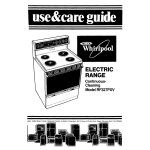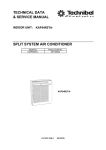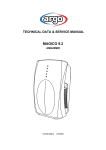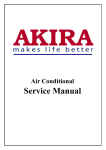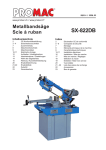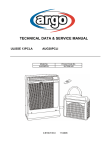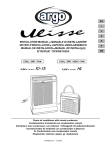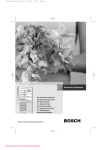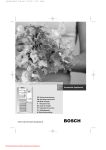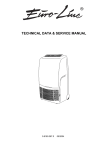Download Argo Ulisse 10 AUR101CL Technical data
Transcript
TECHNICAL DATA & SERVICE MANUAL - AUR101CL COOLING ONLY VERSION (R407C) - AUR131CL - AUR101HL HEAT PUMP VERSION (R407C) ROOM AIR CONDITIONER WITH REMOTE CONDENSER 0.8180.237.0 04/2002 Table of Contents Page A SPECIFICATIONS 1) Unit specifications 2) Major Component specifications 3 3 4 B OPERATING RANGE 5 C DIMENSIONAL DATA 6 D PERFORMANCE CHARTS 7 E REFRIGERANT FLOW DIAGRAM 9 F FUNCTION 1) Cool Mode Operation 2) Heat Mode Operation 3) Auto Mode Operation 4) Dry Mode Operation 5) Fan Mode Operation 6) Protection Operations in Cool and Dry Modes 7) Protection Operations in Heat Mode 8) Cold Draft Prevention (Heating) 9) Sleep Function 10) Daily Timer Function 11) IFEEL Function 12) Manual Unit Control and Led Indicators 13) Recovery from Power Failure 10 10 11 12 13 13 14 16 19 20 20 20 21 21 G ELECTRICAL DATA 22 H TROUBLESHOOTING 24 I PROCEDURE FOR THE REFRIGERANT CHARGE RESTORING 31 L CHECKING ELECTRICAL COMPONENTS 33 33 34 34 1) Measurement of Insulation Resistance 2) Checking Continuity of Fuse on PCS Ass'y 3) Checking Motor Capacitor 2 A SPECIFICATIONS 1) UNIT SPECIFICATIONS UNIT MODEL AUR101CL AUR131CL Power source AUR101HL 220 - 240 V ~ 50 Hz PERFORMANCES COOLING BTU / h Capacity W Air circulation (high/med/low) Moisture removal (high speed) 9045 2650 COOLING HEATING 12525 9560 10720 3670 2800 3140 m3 / h 370/340/270 450/400/340 370/340/270 l /h 1.2 1.5 1.2 ELECTRICAL RATINGS 220 ÷ 240 Voltage rating V Available voltage range V Running ampere A 4.4 6.2 4.2 4.3 Power input W 980 1300 940 950 Power factor % 97 91 97 96 W/W 2.70 2.82 2.98 A 23 34 C.O.P. Compressor locked rotor amperes 198 ÷ 264 3.31 23 FEATURES Controls / temperature control Microprocessor / I.C. Thermostat Control unit Wireless remote control unit Timer ON / OFF 24 hours and program Fan speed indoor / outdoor 3 and auto / 1 Airflow direction (Indoor) Horizontal Manual Vertical Manual Air filter Washable, easy access Compressor Rotary (hermetic) Refrig./Stand. charge at shipmen g 910 1220 1030 Tot. refrig. charge with 2 m extension g 960 1270 1090 Tot. refrig. charge with 4 m extension 1150 Refrigerant control Capillary tube Indoor Hi/Me/Lo dB-A Sound level Outdoor Hi dB-A 44 / 40 / 39 46 / 42 / 41 44 / 40 / 39 54 51 51 Stand. tubing length m ~ 2.5 Tubing length with 2 m extension kit m ~ 4.5 Tubing length with 4 m extension kit m ~ 6.5 DIMENSIONS AND WEIGHT Indoor unit Outdoor unit Height UNIT DIMENSIONS mm 790 Width mm 580 Depth mm 245 Height mm 435 490 490 Width mm 440 525 525 Depth mm Net weight / indoor unit - outdoor unit kg 230 250 250 44 / 9.5 44 / 15 44 / 15 Data subject to change without notice. NOTA Rating conditions: Cooling: Heating: outside air temp.: 35°C DB, indoor unit entering air temp.: 27 °C DB, 19 °C WB outside air temp.: 7°C DB, 6 °C WB, indoor unit entering air temp.: 20 °C DB 3 2) MAJOR COMPONENT SPECIFICATIONS a) INDOOR UNIT MODEL CONTROLLER P.C.B. Controls Control circuit fuse FAN & FAN MOTOR Number / Diameter / Lenght Nominal output Coil resistance (at 25 °C) AUR101CL mm W Ω Safety device Setting Open Close Run capacitor (C1) THERMISTOR (COIL SENSOR) TH1 Resistance (at 25 °C) THERMISTOR (ROOM SENSOR) TH2 Resistance (at 25 °C) COMPRESSOR (Rotary hermetic) Nominal output Compressor oil Coil resistance (at 20 °C) °C °C µF VAC kΩ kΩ W cc Ω SAFETY DEVICES Overload relay (OLR) Operating temperature Open Close °C °C Operating amperes (at 25 °C) MST20ALU-9201 135 ± 5 69 ± 11 Trip in 6 ÷ 16 s at 19 A Open Close °C °C // // Open Close °C °C // // Operating amperes (at 25 °C) Run capacitor (C3) Capacity Voltage CONDENSATE PUMP (PC) Rating Nominal output Coil resistance (at 20 °C) PUMP RELAY (RP) Coil rating Coil resistance (at 20 °C) Contact rating FLOAT MICROSWITCH (MS) Contact rating Float SOLENOID VALVE (4 WAY VALVE) Coil rating Coil resistance (at 20 °C) HEAT EXCHANGE COIL Coil Rows Fin pitch Face area // µF VAC // // 22.5 450 25 450 PC 95643 230 V ~ 50 Hz 12 ± 10 % 122 ± 10 % FINDER 60.62 230 V ~ 50 Hz 7.25 ± 10 % 10 A - 250 V CROUZET F83161.3 10 (4) A - 250 VAC Open Close // // // // W Ω kΩ Up Down Ω MST20ALU-9201 135 ± 5 69 ± 11 Trip in 6 ÷ 16 s at 19 A // // CS-7C115 115 ± 4 95 ± 10 MST56ALU-9202 150 ± 5 69 ± 11 Trip in 6 ÷ 16 s at 22.5 A Overload relay (OLR2) Operating temperature AUR101HL Microprocessor 250 VAC - 3.15 A Cross flow 1 / ø 100 / L 410 27 GRY-WHT: 545 ÷ 630 WHT-VLT: 92 ÷ 105 VLT-YEL: 62 ÷ 71 GRY-BRN: 78 ÷ 90 Internal type 150 ± 10 Automatic 1.0 1.5 1.0 440 440 440 NTC SENSOR 10 ± 5% NTC SENSOR 10 ± 5% 80228245B 80235245B 80228245B 950 1290 950 500 550 500 C-R: 3.01 ± 7% C-R: 1.92 ± 7% C-R: 3.01 ± 7% C-S: 7.02 ± 7% C-S: 5.29 ± 7% C-S: 7.02 ± 7% Overload relay (OLR1) Operating temperature AUR131CL 230 V ~ 50 Hz - 6 W 1440 ± 5 % Aluminium plate fin / Copper tube 2 1.8 0.185 mm m2 4 22.5 450 b) OUTDOOR UNIT (LITTLE BAG) MODEL FAN & FAN MOTOR Number / Diameter No of pole / rpm (220 V, high) Nominal output Coil resistance (at 25 °C) Safety device Open Close Setting Run capacitor (C2) THERMISTOR (COIL SENSOR) TH3 Resistance (at 25 °C) HEAT EXCHANGE COIL Coil Rows Fin pitch Face area B AUR101CL AUR131CL AUR101HL Propeller Propeller Propeller mm 1 / ø 320 1 / ø 380 1 / ø 380 4 / 1205 6 / 860 6 / 860 W 58 70 70 BLU-BRN: 249 ÷ 287 BLU-BRN: 218 ÷ 251 BLU-BRN: 218 ÷ 251 Ω BLU-BLK: 270 ÷ 311 BLU-BLK: 230 ÷ 265 BLU-BLK: 230 ÷ 265 Internal type °C 150 ± 10 °C Automatic µF 2.0 2.5 2.5 VAC 450 450 450 NTC SENSOR kΩ 10 ± 1% 2 1.6 0.227 mm m2 Aluminium plate fin / Copper tube 2 1.6 0.290 2 1.6 0.290 OPERATING RANGE COOLING MODELS Cooling Temperature Maximun Minimum Indoor air intake temperature 32 °C DB / 23 °C WB 19 °C DB / 14 °C WB Outdoor air intake temperature 46 °C DB 19 °C DB Temperature Maximun Minimum Maximun Minimum Indoor air intake temperature 32 °C DB / 23 °C WB 19 °C DB / 14 °C WB 27 °C DB / 19 °C WB - DB / - WB Outdoor air intake temperature 46 °C DB 19 °C DB 24 °C DB / 18 °C WB -8 °C DB / -9 °C WB HEAT PUMP MODELS Cooling Heating 5 C DIMENSIONAL DATA Indoor unit 790 835 580 245 245 435 (* 490) 425 Outdoor unit 440 440 (* 490) 230230 (* 250) DIMENSIONS: mm * HEAT PUMP MODEL AND AUR131CL 6 PERFORMANCE CHARTS Operating characteristics versus outdoor ambient temperature and indoor temperature. Conditions: Power source Indoor air velocity Refrigerant Tubing length 230 V - 1 - 50Hz - Single phase High Amount charged at shipment 2,5 m Cooling characteristics Indoor relative humidity 46% AUR101CL 5.2 32 4.8 27 4.6 OPERATING CURRENT - A 4.4 19 4.2 4.0 3.8 3.6 INDOOR INLET AIR D.B. TEMP. (°C) 5.0 3.4 3.2 20 25 30 35 40 45 OUTDOOR INLET AIR D.B. TEMP. (°C) AUR131CL 32 6.5 27 6.0 5.5 19 5.0 4.5 4.0 3.5 3.0 20 25 30 35 OUTDOOR INLET AIR D.B. TEMP. (°C) 7 40 45 INDOOR INLET AIR D.B. TEMP. (°C) 7.0 OPERATING CURRENT - A D Operating characteristics versus outdoor ambient temperature and indoor temperature. Conditions: Power source Indoor air velocity Refrigerant Tubing length 230 V - 1 - 50Hz High Amount charged at shipment 2,5 m HEAT PUMP MODELS Cooling characteristics Indoor relative humidity 46% … 5.0 … 5.2 32 27 4.6 4.4 19 4.0 … OPERATING CURRENT - A 4.2 3.8 3.6 3.4 INDOOR INLET AIR D.B. TEMP. (°C) 4.8 3.2 3.0 20 25 30 35 40 45 OUTDOOR INLET AIR D.B. TEMP. (°C) Heating Outdoor relative humidity 85% 24 5.0 4.5 18 4.0 … OPERATING CURRENT - A 20 3.5 3.0 -10 -5 0 5 10 15 OUTDOOR INLET AIR D.B. TEMP. (°C) 8 20 25 INDOOR INLET AIR D.B. TEMP. (°C) … … 5.5 REFRIGERANT FLOW DIAGRAM COOLING MODELS Indoor unit Heat exchanger Heat exchanger Mechanical filter Outdoor unit CAPILLARY TUBE Compressor Accumulator QUICK CONNECTOR REFRIGERANT FLOW DIAGRAM HEAT PUMP MODELS Compressor Indoor unit Accumulator Muffler 4-way valve Heat exchanger Outdoor unit Heat exchanger E Capillary tube Capillary tube ( ) Quick connector Stainer Drier Check valve Cooling cycle Heating cycle 9 F FUNCTION 1 Cool Mode Operation (RT - SPT) [ oc] +3 +2 +1 0 -1 over 3 min over 5 min ON COMP OFF ON OFAN OFF over 30 sec H IFAN M L ON RV OFF In Cool Mode, the operation of the Compressor (COMP), Outdoor Fan (OFAN) and Indoor Fan (IFAN) are determined by the difference between the Room Temperature (RT) and the Set Point Temperature (SPT) as in the graph above. Notes: 1. In this graph, the IFAN is operating in the “Auto Fan Speed” setting. If the user has selected the low, medium or high fan speed, the IFAN will run constantly at that speed only. 2. In addition to the value of (RT-SPT), the operations of the relays are also controlled by protection delays. For example, (a) the minimum On/Off time of the COMP is 5 min and 3 min respectively, and (b) the IFAN can change speed only after it has operated at the same speed for 30 sec. 10 2 Heat Mode Operation (RT - SPT) [oc] +1 0 -1 -2 -3 ON COMP OFF 30 sec H M IFAN L OFF Note 1 Note 2 ON RV OFF The Heat Mode operation is similar to the Cool Mode operation. The COMP, OFAN and IFAN are mainly controlled by the value of (RT – SPT). In the graph above, the IFAN is operating in Auto Fan speed mode. Therefore, the IFAN speed changes automatically according to the (RT - SPT). Note 1: The 30s IFAN operation is for purging the heat from the in-coil after COMP has stopped. Note 2: The IFAN will not be turned on until the in-coil temperature is high enough (as shown in the graph below) to prevent the unit from supplying cool air. IFAN Speed ICT = In-coil Temperature Any = Hi, Med or Low fan speed which is selected by the user. In Auto Fan Speed Mode, the fan speed is selected by the unit automatically instead. Any Low Low = The indoor fan is forced to operate at low speed Stop 30 35 40 ICT [oc] 11 3 Auto (Cool/Heat) Mode Operation (RT - SPT) [oc] +2 +1 0 -1 -2 ON COMP & OFAN OFF ON RV OFF Auto Heat Mode Auto Cool Mode Auto Heat Mode In Auto Mode, the unit switches between the Auto Cooling Mode and Auto Heating Mode automatically to maintain the room temperature (RT) at the set point temperature (SPT). 12 4 Dry Mode Operation (RT - SPT) [oc] +2 +1 0 10 20 40 30 50 Time [min] -1 -2 DRY-ON DRY DRY-OFF LOW IFAN OFF 5 minutes COMP ON time ON COMP & OFAN OFF Max 15 minutes 3.5 min Max 15 minutes (Note 1) 6 min (Note 2) In Dry Mode, the unit operates in a mild cool mode to lower the humidity of the room. In order to maintain a high efficiency in the drying operation without over lowering the room temperature excessively, the Dry Mode is different from the Cool Mode in two ways. 1. The IFAN is forced to operate at low speed only. And, the IFAN is turned off with the COMP. 2. The unit operates in either the “Dry-on” state or the “Dry-off” state. If RT = SPT, the unit will operate in “Dry-off” state. The COMP is forced to operate for 6 min after it has stopped working for 15 min. If RT > SPT, the unit will operate in “Dry-on” state. The COMP is forced off for 3.5 min after it has been working for 15 min. Note 1: COMP is forced off in Dry-on state. Note 2: COMP is forced to operate in Dry-off state. 5 Fan Mode Operation In Fan Mode, the indoor fan is turned on to improve the air circulation in the room. COMP and OFAN remain OFF all the time. Note: If the user has selected the Auto Fan Speed setting, the IFAN speed would be selected by the unit automatically according to the difference between RT and SPT, as in Cool Mode. 13 6 Protection Operations in Cool and Dry Modes 1. Indoor Coil Defrost Protection The in-coil defrost protection can prevent the ice formation at the in-coil when the ambient temperature is low. ICT [oc] +5 +2 +1 0 -1 t1 t2 t3 ON OFAN OFF ON COMP OFF ON IFAN OFF t1 = 5 min minimum for each COMP starting t2 = OFAN cycling (alternate between ON and OFF every 30 sec) for 20 min maximum t3 = COMP and OFAN stop for 10 min minimum 14 2. Outdoor Coil High Pressure Protection The out-coil high pressure protection prevent the build up of high pressure at the out-coil during cooling operation. OCT [oc] 64 61 55 52 ANY COMP OFF COMP is forced OFF OFAN follow operation of COMP ANY OFAN OFAN is forced ON (Note 1) ON ANY IFAN L IFAN is forced LOW ON OPER LED Note 1: BLINK In some applications, the outdoor fan and the compressor are controlled together by the COMP relay output from the controller. In this case, it will take more time for the out-coil to cool down during the high pressure protection, because the outdoor fan will be turned off with the compressor instead of working as in the graph above. 15 7 Protection Operations in Heat Mode 7-1 Outdoor Coil Deice Protection The deice process is controlled by an Ice Detection Algorithm (IDA). The IDA is an unique control algorithm incorporated to maintain optimal utilization of the heat pump capacity, especially in below-zero outdoor temperature condition. The out-coil deicing will be activated not only by static temperature detection as normally done, but also while ice forming is detected on the out-coil. COMP to ON DI = 40 (or 10) DT = 5 1 Activate DDt setting Routine Start counting TLD DTF = 0 OCT < DOC ? No Yes DDT and DTF information from Deicing Dynamic Threshold setting routine No TLD > DI & OCT < DST (during last 3 minutes) DTF=1 & OCT < DDT (during last 3 minutes) & ICT < 40 deg No Yes Yes Deicer activation (see Notes) Deicer activation (see Notes) LDT > DT + TimeD LDT < DT-TimeD or LDT < DTmin No Yes Yes DI = TLD - DIT DI = TLD + DIT No No DI = TLD DI < DImin Yes DI = DImin No DI > DImax Yes DI = DImax DT = LDT 1 16 1st COMP start, OR deice complete Yes No Reset TLD cnt to 0 DTF = 0 IFAN/OFAN speed change Yes No Reset SCT cnt to 0 DTF = 0 TLD > TST AND SCT > SCD Yes No DDT = OCT - TempD DTF = 1 DDT and DTF information to main algorithm Explanation: The “Ice Forming Detection” will be done by two algorithms – 1. In Dynamic Temp Detection, the ice formation will be detected by (i) Compare the OCT with a Deicing Dynamic Temperature Threshold, and (ii) Detect the drop in ICT which accompany the ice formation. 2. The Static Temp Detection will be done by comparing the OCT with a Deicing Static Temperature Threshold. The Deicing Data Record is used to determine the time delay between two deicing cycles. In general, the time delay will be increased if the last deicing cycle can be completed quickly. 17 7-2 Indoor Coil High Pressure Protection in Heat Mode The in-coil high pressure protection prevent the build up of high pressure at the in-coil during heating operation. ICT [oc] 64 A B ANY COMP OFF COMP is forced OFF ANY OFAN OFF Note: The operation temperatures shown as A and B in the chart differ by models. A B WSA-78 50 42 WSA-98 54 45 WSA-128 58 50 18 8 Cold Draft Prevention (Heating) • This function controls indoor fan speed so a strong draft of cold air will not blow out before the indoor heat exchange coil have sufficiently warmed up. • When 10 minutes has elapsed, the fan speed is automatically switched to set speed regardless of indoor heat exchange coil temperature. Indoor heat exchange coil temp. (°C) Max.10 minutes Tc Indoor Fan OFF Set Speed NOTE • The operation temperature shown as Tc in the chart differ by models. Tc WSA-78 32 WSA-98 32 WSA-128 34 19 9 Sleep Function Room temperature is automatically controlled to compensate for body temperature variations while sleeping. This mode of operation is designed for maximal comfort in both COOL and HEAT modes. RT Unit is turned to SB after Sleep 7-12 Hours Sleep operation SPT+3 Cool, Dry modes SPT+2 SPT+1 SPT SPT-1 SPT-2 Heat mode SPT-3 Start Sleep 1 2 3 4 7 - 12 Time [Hr] 10 Daily Timer Function Unit can be programmed to be ON and OFF automatically at preset time everyday, by using a remote controller. The resolutions of the ON/OFF timers are 10 min. 11 IFEEL Function This feature is provided if the unit is used together with a remote controller with the I-FEEL function. When this function is selected, the remote controller sends the room temperature measured by its build-in thermistor to the air con for more accurate temperature control. 20 12 Manual Unit Control and LED indicators The push button switch and the LED indicators on the display panel let the user to control the unit operation without a remote controller. Their operations are provided below. LED indicators: STAND BY INDICATOR OPERATION INDICATOR TIMER INDICATOR 1. Lights up when the Air Conditioner is connected to power and ready to receive the R/C commands 2. Blinks continuously in case of any thermistor failure. 1. Lights up in operation mode (Note: OFF in standby mode). 2. Blinks for 0.5 sec., to announce that a R/C infrared signal has been received and stored. 3. Blinks continuously during ? OCT High Pressure Protection Mode ? Deicing in Heating Mode 1. Lights up during Timer and Sleep operation. 2. Active On/Off timer setting will become invalid after a power failure. When this happens, the unit is forced to restart in STBY mode, and the Timer Indicator is blinked continuously until (i) the unit is switched to OPER Mode again, or (ii) any message from the R/C is received. Push Button switches: MODE BUTTON (Cool, Heat, SB) Use to cycle the operation mode of the A/C unit among COOL, HEAT and SB modes, without using the R/C. Every time this switch is pressed, the next operation mode is selected, in the order : SB => Cool Mode => Heat Mode => SB => ... 13 Recovery from Power Failure Last unit settings (SPT, operation mode, etc) are saved in the EEPROM in the unit. In case of power failure, these settings are restored automatically. 21 ELECTRIC WIRING - COOLING ONLY VERSION • SCHEMA ELETTRICO - VERSIONE SOLO RAFFREDDAMENTO • SCHÉMA ÉLECTRIQUE VERSION FROID SEUL • SCHALTPLAN - AUSFÜHRUNG: NUR KÜLUNG • ESQUEMA ELECTRICO SCHALTPLAN - MODELOS QUE SOLO EINFRIAN • HLEKTRIKO DIAGRAMMA - EKDOSH MONO YUXH AUR101CL AUR131CL 22 ELECTRIC WIRING - HEAT PUMP VERSION • SCHEMA ELETTRICO - VERSIONE POMPA DI CALORE • SCHÉMA ÉLECTRIQUE - VERSION POMPE À CHALEUR • SCHALTPLAN - WÄRMEPUMPE-AUSFÜHRUNG • ESQUEMA ELECTRICO SCHALTPLAN - MODELOS BOMBA DE CALOR • HLEKTRIKO DIAGRAMMA - EKDOSH ME QERMOANTLIA 23 TROUBLESHOOTING H CHECK BEFORE AND AFTER «TROUBLESHOOTING» (A) Check power supply wiring. ● WARNING: If the following troubleshooting must be done with power being supplied, be careful about any uninsulated live part that can cause ELECTRIC SHOCK. (B) Check power supply. ● ● Check that voltage is in specified range (± 10% of the rating). Check that power is being supplied SYSTEMATIC CHART OF «TROUBLESHOOTING» AIR CONDITIONER DOES NOT OPERATE A Circuit breaker trips (or fuse blows) ● When circuit breaker is set to ON, it trips in a few moments. (Resetting is not possible). Measure insulation resistance there is a possibility of ground fault. If resistance value is 1 MOhm or less, insulation is defective. ● B 1 Circuit breaker trips in several minutes after turning air conditioner ON. ● There is a possibility of short circuit. NO Check capacity of circuit breaker. Capacity of circuit breaker is suitable? Replace it with suitable one. (Larger capacity) YES Measure resistance of compressor motor winding. YES Measure resistance of outdoor fan motor winding. 2 ● Neither indoor unit nor outdoor unit runs. Power is not supplied. Check power supply. Is power being supplied to wall receptacle? Circuit breaker is tripped. Reset the breaker Power failure. Wait for recovery or contact power company. NO Check fuse on PCB Ass’y in outdoor unit. Check fuse on PCB Ass’y in indoor unit for continuity. If fuse blows, there is a possibility of short circuit. Measure resistance of indoor fan motor winding. 24 C Water - level alarm (condensate) is blinking Malfunctioning of the condensate drainage system to the outdoor unit NOTE - In case of emergency the air conditioner can work by draining the condensate from the back little pipe into a rather short container, extract the little pipe and remove the cap. YES The condensate drain pipe in the flexible connection pipe is bended or obstructed Remove the obstruction NO Check electrical components (connections and continuity of internal wiring) YES Check limit float switch (MS) DEFECTIVE Replace limit float switch (MS) YES Check drain pump motor (PC) DEFECTIVE Replace drain pump D Only outdoor unit and compressor do not run Outdoor unit does not run when air conditioner is in following conditions. ● ● When the room temperature is below the setting temperature. During freeze prevention. Check setting temperature Try to lower setting temperature by temperature setting button Outdoor unit does not run Is room temperature too low? NO Check room sensor (thermistor TH2). OK 25 PCB assy is defective. E SOME PART OF AIR CONDITIONER DOES NOT OPERATE 1) ONLY INDOOR FAN DOES NOT RUN Check fan rotation. Turn fan gently once or twice by hand. Check fan motor capacitor. Fan cannot be turned DEFECTIVE Check fan casing for foreign matter on inside. Remove foreign matter or repair. Fan motor burnout or foreing matter in bearing. Repair or replace. Replace. OK Measure resistance of fan motor winding. DEFECTIVE Replace fan motor. 2) ONLY OUTDOOR FAN DOES NOT RUN Check fan rotation. Turn fan gently once or twice by hand. Check fan motor capacitor. Fan cannot be turned DEFECTIVE Check fan casing for foreign matter on inside. Remove foreign matter or repair. Fan motor burnout or foreing matter in bearing. Repair or replace. Replace. OK Measure resistance of fan motor winding. DEFECTIVE Replace fan motor. 3) ONLY COMPRESSOR MOTOR DOES NOT RUN Measure resistance of compressor motor winding. Check overload relay (OLR). It his tripped. YES OK Check compressor motor capacitor. Is temperature of compressor abnormally high? YES OK YES Refrigerant gas shortage. NO Check compressor. There is a possibility of locked rotor. 26 Charge refrigerant gas. YES Replace the compressor. F AIR CONDITIONER OPERATES, BUT ABNORMALITIES ARE OBSERVED (HEAT PUMP MODEL) 1) Operation does not switch from heat to cool (or cool to heat) Remote control unit may be defective. Receiver Ass’y may be defective. Measure resistance of solenoid coil winding (20 S - 4-way valve) (2) Check “PUSH BUTTON” in indoor unit on monitor panel • • Push the button switch under the Push the button switch under the indoor unit pannel. indoor unit pannel. The indoor unit and outdoor unit doesn’t runs Indoor PCB Ass’y is defective (3) Check remote control unit. Try to run using another remote control unit. YES First remote control unit is defective. NO Check for residue duildup on transmitter of remote control unit. NO Check for residue buildup on remote control receiver on front of indoor unit. 27 Clean transmitter. Clean receiver. (4) Check fuse on PCB Ass’y in indoor unit. Check fuse on PCB Ass’y in indoor unit for continuity. If fuse blows, there is a possibility of short circuit. Measure resistance of indoor fan motor winding (FMI). OK PCB Ass’y in indoor unit is defective. (5) Check setting temperature. COOL HEAT Is room temperature too low? Is room temperature too high? NO NO Try to lower setting temperature by temperature setting button Try to raise setting temperature by temperature setting button Outdoor unit still does not run • Outdoor unit still does not run • Try to use another remote control unit OK • Try to use another remote control unit OK • Remote control unit is defective 28 Remote control unit is defective G POOR COOLING OR POOR HEATING Check position of remote control unit. Cool or warm air from air conditioner reaches position directly. Change position of remote control unit. NO Are wide and narrow tubes between indoor unit and outdoor unit insulated? Insultate wide and narrow tubes and then tape together. SI Measure temperatures of suction and discharge air of air conditioner. Possibility of gas shortage? Charge refrigerant gas. Temperature difference between suction and discharge air is large enough (approx. 10 °C. or more). Air filter is clogged. Is fan speed set to LOW? YES YES Review cooling or heating load estimate, if performance of air conditioner is normal. H Clean filter Set fan speed to either high or medium. Reduce cooling or heating load or replace unit with larger capacity. EXCESSIVE COOLING OR HEATING Remote control unit is placed where it can detect room temperature property. Change position of remote control unit. 29 I IF A SENSOR IS DEFECTIVE ICT (indoor coil sensor) OCT (outdoor coil sensor) RAT (room ambient temperature) are defective. • Stand by lamp on front side of indoor unit is blinking. (*) • YES Thermistor ICT and OCT and RAT are defective YES • Replace thermistor. NOTE Allarm signal (*) Stanby lamp on the front side of the indoor unit will blink when the thermistor is defective. At the same time the outdoor unit will stop. Indoor operate only for ventilation. Temperature sensor Leads wires 30 I PROCEDURE FOR THE REFRIGERANT CHARGE RESTORING TOTAL REFRIGERANT CHARGE R407C AUR101CL AUR131CL AUR101HL STANDARD UNIT 910 g 1220 g 1030 g UNIT WITH EXTENSION KIT OF 2 m 960 g 1270 g 1090 g UNIT WITH EXTENSION KIT OF 4 m 1010 g 1320 g 1150 g NOTE: The extension kits are supplied precharged. In order to ensure quick and safe connection to the vacuum pump, use the connection device which can be bought near Argo Service Dept. The service connection kit is supplied with 3/8” male aeroquip and copper tube at the other end. Plastic protection Plastic plug (Aeroqiup quick connection protection). Connection with the vacuum pump through a throttle valve, 8 mm diameter. Connection to the vacuum pump through a service valve (plunger) welded to the service connection (quick connection to the pump pipes). Hose vacuum pump Reload of the system after a maintenance intervention or after an uncorrect detach of the connection pipe. Before disconnecting the unit, pay attention to follow the warning shown hereunder. CAUTION Before disassembling the outdoor unit (disjoin the rapid couplings): connect the air conditioner to a socket and let the compressor work for 5 minutes. In case of refrigerant small leakage during the disconnecting operation of the outdoor unit, reconnect the rapid and beat lightly with a spaller on the rapid couplings brass body (exagonal part). Apply anti-freeze oil to the rapid couplings before reconnecting therm. 31 Before starting the bleeding of the system, it is advisable to oil the quick connections with antifreezing oil (HAB OIL), and then connect and disconnect once the system, in order ensure that seals of the piston. Indoor unit bleeding Joint the service connection to the low pressure pipe of the vacuum pump, according to above instructions, the screw it to the female aeroquip connection of the indoor/outdoor connection pipe. Make vacuum inside the indoor unit (10 mm Hg. abs.). Restore the freon charge (see table). Then detach the vacuum pump (check the sealing of the aeroquip quick connections). WARNING The full charge of refrigerant must be restored to the indoor unit. Outdoor unit (little bag) bleeding. Connect the vacuum pump already equipped with service connection to the female aeroquip connector of outdoor unit (little bag) then to perform vacuum operation (vacuum 10 mm Hg abs.). WARNING Inside the outdoor unit make vacuum only, without freon charge. Oil both indoor and outdoor unit aeroquip connections with antifreezing oil (HAB OIL), then join the units (torque 150 ÷ 165 kgcm). Wait 10 minutes to equalize the pressure inside the system and then start the air conditioner, checking anyway the seal of the connections. Place the cover on the outdoor unit top. 32 L CHECKING ELECTRICAL COMPONENTS 1) Measurement of Insulation Resistance EATHER LINE ● The insulation is in good condition if the resistance exceeds 1MOhm. CLIP PROBE INSULATION TESTER a) Power Supply Wires Clamp the earthed wire of the power supply wires with the lead clip of the insulation resistance tester and measure the resistance by placing a probe on either of the power wires (Fig. 1). Then measure the resistance between the earthed wire and the other power wires (Fig. 1). Fig. 1 TERMINAL PLATE PROBE b) Indoor unit Clamp an aluminium plate fin or copper tube with the lead clip of the insulation resistance tester and measure the resistance by placing a probe on N terminal, and then on L terminal the terminal plate (Fig. 2). CLIP COPPER TUBE OR METALLIC PART Fig. 2 PROBE c) Measurement of Insulation Resistance for Electrical Parts CLIP Disconnect the lead wires of the disired electric part from terminal plate, PCB Ass’y, capacitor, etc. Similarly disconnect the connector. Then measure the insuration resistance. (Fig. 1 to 4). Refer to Electric Wiring Diagram COPPER TUBE OR METALLIC PART INSULATION TESTER Fig. 3 NOTE ● If the probe cannot enter the poles because the hole is too narrow then use a probe with a thinner pin. FROM FAN MOTOR, COMPRESSOR AND OTHER PARTS METALLIC PART CLIP PROBE INSULATION TESTER Fig. 4 33 2) Checking Continuity of Fuse on PCB Ass’y ● Remove PCB Ass’y from electrical component box. (Fig. 5). ● FUSE Then pull out the fuse from PCB Ass’y. PCB ASS’Y Fig. 5 ● Check continuity of fuse by the multimeter (Fig. 6). FUSE Fig. 6 3) Checking Motor Capacitor ● Remove the lead wires from the capacitor terminals, and then place a probe on the capacitor terminals as shown in Fig. 7. Observe the deflection of the pointer, setting the resistance measuring range of the multimeter to the maximum value. The capacitor is “good” if the pointer bounces to a great extent and the gradually returns to its original position. The range of deflection and deflection time deffer according to capacity of the capacitor. MULTIMETER COMPRESSOR MOTOR CAPACITOR FAN MOTOR CAPACITOR Fig. 7 34 Tel. +39 0331 755111 - Fax +39 0331 776240 www.argoclima.it Printed in italy Via Varese, 90 - 21013 Gallarate - Va - Italy



































